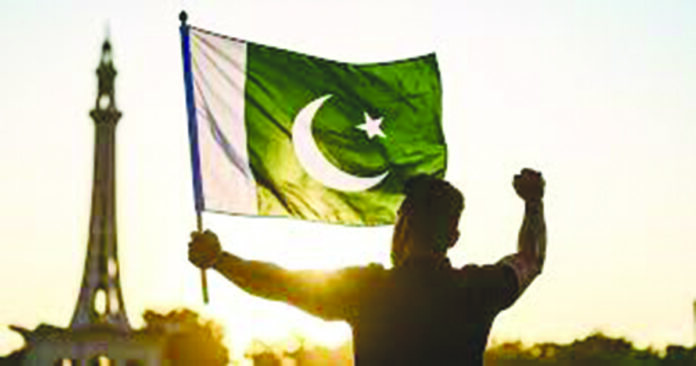Copyright pakistantoday

“I want to ask a question from Mr. Victor Gao,” said a young NUSTIAN, his voice echoing across the packed auditorium during Islamabad Symposium at NUST last month. “Sir, we see China making so much progress, and today it has become a great power. I just want to ask— can Pakistan also become a great power like China?” he spoke his heart out to Victor Zhikai Gao, the eminent Chinese scholar and IR expert. Gao’s response was concise yet profound. By reaffirming that Pakistan already occupies a significant position in the international community, he enunciated that it possesses immense potential to rise as a great power by virtue of its geostrategic location, abundant natural resources and a young and dynamic population. “But”, Gao added after a brief pause, “Pakistan needs to do three things, ensure internal peace and stability, focus on (economic) development, and make its defence strong.” He summarized Pakistan’s performance and potential in one sentence! Gao’s recipe of nation building is neither new nor unique. Many scholars, leaders and policymakers have long been emphasizing the role of state institutions– political, economic and military– in its rise and fall. Robinson and Acemoglu in their joint work– Why Nations Fail– state the following three succinct reasons for a state’s success and failure alike: “institutions; institutions; and institutions.” On 11 August 1947, Quaid-e-Azam Muhammad Ali Jinnah articulated his vision for Pakistan during his historic address to the First Constituent Assembly. His golden words continue to serve as doctrinal principles for building a great nation. With regard to internal peace, the Quaid emphasized: “The first duty of a government is to maintain law and order, so that the life, property, and religious beliefs of its citizens are fully protected.” On economic development, he declared: “If we want to make this great State of Pakistan happy and prosperous, we should wholly and solely concentrate on the well-being of the people, and especially of the masses and the poor.” Whereas, he reflected his political wisdom and moral clarity in these guiding words: “I shall always be guided by the principles of justice and fair play.” Are we truly following in the footsteps of the Father of the Nation? The answer lies in a comparative analysis of Pakistan relative global standing vis-à-vis its potentials– across the political, economic and security paradigm. Then there is the military strength which is merely not related to defence budget, size of armed forces and lethality of arsenals, but to military achievements to uphold internal cohesion and external stability. Pakistan armed forces stand at much higher pedestal when compared with contemporary world armies. Pakistan Army, by all definitions, is the country’s centre of gravity where it has negotiated many internal and external challenges successfully. Statistics, though, show a diverging mismatch in Pakistan’s potentials and performance but cannot negate Pakistan’s prospects of becoming a great nation. Let’s first examine Pakistan’s performance as a member of international community – beginning with its political ranking. Various political analysts and research organizations around the globe maintain a comparative democratic index based on scores of parameters and group them in four types of democratic categories: full, flawed, hybrid and authoritarian regimes. According to The Economist Intelligence Unit (EIU) annual democracy index published since 2007, Pakistan has never been placed in the first two categories. After remaining in the hybrid category till 2022, Pakistan relegated to the last group– the authoritarian regimes. Whereas it was ranked 107th among 167 states as a Hybrid Regime, Pakistan’s ranking was downgraded to 118th and 124th position in 2023 and 2024 respectively. The erosion of Islamabad’s democracy index reflects weaknesses in several components like: electoral process and pluralism; civil liberties; the functioning of government; political participation; and political culture. Now, let’s discuss Pakistan’s economic health through the following indicators in 02024: GDP volume, GDP growth, GDP per capita, trade volume, infrastructure development, education system, revenue collection, inflation and control on corruption. With a GDP volume of around $373 billion, and GDP growth rate of 2.6 percent, Pakistan is the 44th largest economy in the world. The other indicators reflect: GDP per capita– meagre $1,391 (60th position); trade volume – only $89 billion (with over 24 percent in trade deficit); and only 0.12 percent contribution to global export. Where states allocate huge budgets on infrastructure development, Pakistan is far below in the list with just 1.9 percent of GDP on Pub0lic Sector Development Programme (PSDP). In education and technological development, Pakistan is listed at 139th position out of 153 countries (2014 data) with a literacy rate of slightly over 60 percent. Where others spend 4-6 percent, Pakistan spends less than one percent of GDP on education. As regards revenue collection, with its tax-to-GDP ratio at 11.6 percent, the country is at 180th /190 position. Furthermore, with alarming inflation at over 30 percent in 2023, Pakistan has shown improvement to near 13 percent in 2024. Finally, as per Transparency International Corruption Perception Index 2024, Pakistan ranks 135th out of 180 in the list of cleanest nations. Now, let’s have a look at Pakistan’s security mosaic– which remains complex and multidimensional shaped by both external and internal threat perceptions. Externally, Pakistan’s foremost concern is India-centric where Kashmir and other strategic issues define Pakistan’s threat perception. Simultaneously, the ongoing conflict with Afghanistan has generated a two-front challenge to collectively test Pakistan’s conventional and strategic equilibrium, making external security a persistent concern. On the internal front, Pakistan faces a series of interlinked terrorist and sub-state challenges. Periodic terrorist attacks continue to claim the lives of both security forces and civilians, making the internal security environment volatile and unpredictable. Three major characteristics define this internal security landscape: (1) Provincial Variation: the manifestation of threats differs from province to province and even region to region– necessitating specialized responses; (2) Multiplicity of Actors: with multiple fronts activated simultaneously, a blend of internal and external actors– state, non-state, and hybrid– shapes Pakistan’s complex security picture; and, (2) Convergence of Adversarial Interests: despite differing motives, foreign and local hostile entities share the single strategic goal of destabilization of Pakistan. The country’s internal security presents the following picture. In KP, the security situation remains largely trans-national, with threats linked to cross-border terrorism from Indian-sponsored groups in Afghanistan. Baluchistan experiences a mix of sub-nationalist and trans-national threats, involving both foreign sponsors and local insurgent networks, aiming to exploit ethnic and economic grievances. Punjab and GB face sectarian challenges– though not grown in size and intensity. Though Sindh enjoys relative peace after years of unrest, criminal mafias and dacoit networks in interior Sindh undermine law and order. Finally, in AJK political rivalries and interests have occasionally triggered law and order disturbances, adding to the broader internal security pressures. Pakistan’s security paradox lies in its simultaneous strength and fragility. While its armed forces and nuclear deterrence ensure strategic stability, internal fissures, external hostilities, and hybrid threats keep the nation in a perpetual state of vigilance. The convergence of internal insurgencies, cross-border terrorism, and foreign interference creates a multi-front challenge– demanding integrated civil-military coordination, regional diplomacy, and socio-economic resilience. Let’s now discuss Pakistan’s potential to rise as a great power through various indicators related to the country’s political, economic and security dynamics. First the political signs. Though Pakistan shades in the last category of democracy index, still it shows many positive signals which include: (1) despite political fragmentation all political parties share unanimity on strategic issues like the nuclear programme, Kashmir policy, India, Afghanistan and political culture– though there is some difference on modalities; (2) while the country has experienced many crises, the nation and its leadership has always exhibited a resilient character; and, (3) registration of 166 political parties in ECP shows the nation’s resolve to have democracy as form of government. Now, the economic potentials which largely depend upon a state’s: natural resources; human resource; and, capital resources. It goes without saying that through CPEC and energy corridors like IP and TAPI, Pakistan enjoys significant geostrategic advantage. As regards to energy and natural sector Pakistan ranks 30th, 50th and 28th in terms of possessing proven reserves of natural gas, crude oil and coal respectively. The country is also rich in gold and copper deposits. The porphyry deposits of Reko Diq are estimated at 15 million tons of copper and 26 million ounces of gold (43rd in the world) which are apart from other minerals like: Chromium Ore, Gypsum, Iron Ore, Lead, Salt and Zinc, with a considerable global share. Furthermore, agriculture accounts for 24 percent of the GDP and employs 37 percent of the labour force. Out of 3,63,030 SQ KM of Pakistan’s total agriculture land, over 80 percent is arable. Besides, Pakistan is also the world’s largest producer and supplier of crops, being with 5th largest in cotton and sugarcane; 4th in mangoes; 7th in wheat; 9th in rice; 20th in maize; and, 18th in the world in potato production. There are also several areas that remain relatively unexplored yet hold immense untapped potential. These include the blue economy, glaciated water resources, and the industrial sector. Then there is the military strength which is merely not related to defence budget, size of armed forces and lethality of arsenals, but to military achievements to uphold internal cohesion and external stability. Pakistan armed forces stand at much higher pedestal when compared with contemporary world armies. Pakistan Army, by all definitions, is the country’s centre of gravity where it has negotiated many internal and external challenges successfully. The above statistics, though, show a diverging mismatch in Pakistan’s potentials and performance but cannot negate Pakistan’s prospects of becoming a great nation.



